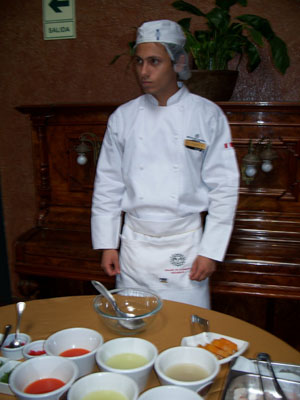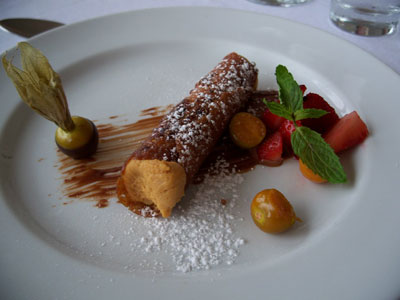Lima, with a culinary twist
This item appears on page 59 of the May 2011 issue.
by Deanna Palic (Second in a series)
As a Food Channel aficionado, I found this aspect of touring Lima a real treat. My visit in November 2010 was my first time visualizing the city’s history through its cuisine. I was part of a press group invited by Canatur and PromPerú, and our culinary excursion started at the Surquillo market, a few blocks from Parque Kennedy in Miraflores.
Products from around the country can be found there: fruits from the Amazon and the Andes; some of the 4,000 varieties of Andean potatoes, and buckets of quinoa, the grain of the Incas.
Quinoa, pronounced “keen-wa” in the Quechua language, has been cultivated in the Andean highlands for over 7,000 years, yet it is a relative newcomer in the United States. A gluten-free product and, thus, suitable for anyone afflicted by wheat allergies, it is easily digestible and a perfect base for vegetarian dishes.
Perú is also home to at least 2,000 kinds of fish as well as a huge diversity of corn and chilies, many of which are on display in the Surquillo market.
The market is expected to undergo (eventually) a massive renovation, spearheaded by Gastón Acurio, hailed in Portfolio magazine as the next international “super chef.” Produce will remain on the ground floor, while a food court and his cooking school will be added on the second and third floors.
Acurio’s mission is to carry Peruvian culture to the world by opening more restaurants. He has already conquered South America and has made inroads in North America and Europe, with successful restaurants in San Francisco (La Mar Cebicheria Peruana, on the Embarcadero) and Madrid (the casual bistro T’anta). It is said that New York City and Toronto are in his sights.
In Lima, he and his wife operate Astrid y Gastón Cocina Peruana (175 Calle Cantuarias; phone [0] 1 242 5387).
Dining among the ruins
Our group first toured the historic ruins of Huaca Pucllana, an archaeological compound located in the middle of a residential area in Miraflores.
Construction of the compound took place between AD 200 and 700 by the early inhabitants of Lima. The adobe pyramids form a complex that was one of the main administrative and ceremonial centers of the Lima culture.
After a guided tour, we walked to the restaurant La Huaca Pucllana (General Borgoño Cdra 8 s/n, Miraflores, Lima, Perú; phone 445 4042), furnished in the style of a colonial country house, with a prevalence of the rustic harango wood. From the covered terrace, in the evening there are some amazing views of the illuminated ruins.
The cuisine is a reinterpretation of the Peruvian criollo tradition by Chef Marilú Madueño (Le Cordon Bleu Paris). She combines the local flavors and ingredients with contemporary techniques to produce main courses costing $10-$15.
To start, we each were given a choice of a Pisco Sour or glass of wine. As an appetizer, we had Causa Rellena, a cooled yellow potato seasoned with chili, then stuffed with shrimp, tomato and avocado. The main course was Trucha a la Plancha, trout fillets grilled in butter and seasoned with Andean herbs. A mixture of hearts of palm, Andean potatoes seasoned with red chili and peanuts accompanied the trout.
The canutos, for dessert, were exceptional. A pastry shell, fashioned from quinoa, is filled with a lúcuma mousse and topped with a chocolate sauce. Lúcuma is an ancient subtropical fruit that originated in the Andes.
Soda, mineral water, coffee or tea concluded the meal, which cost a total of 70 nuevos soles (at the time, about $19). As I write this, three months later, due to the decline of the dollar, this same meal would cost $26.
La Huaca Pucllana is open 12:30 to midnight Tuesday-Saturday and 12:30-4 p.m. Sunday.
Pisco Sours and ceviche
Our culinary education continued the following day at the trendy restaurant Brujas de Cachiche (Calle Bolognesi 472, Miraflores; phone 447 1883).
In the cozy bar, where the walls are lined with original pisco (grape brandy) casks, we learned how to make the national drink, a Pisco Sour. Instructing us was the bartender, winner of Peru’s 2009 Pisco Sour competition. Ingredients consist of fresh lime juice, pisco, sugar and egg whites.
A bit tipsy from our pisco encounter, we negotiated the stairs to the restaurant’s second level. Our chef, a national ceviche-competition winner, awaited us for our class in its preparation.
Ceviche was originally created by fishermen as a way to eat part of their catch during long days at sea. Ceviche uses the acid in lime juice to “cook” the fish, but our instructor carried this technique a bit further. He mixed a seafood broth into the lime juice.
Once the fish was ready, it was plated and surrounded by chunks of choclo (corn), chili and hunks of cold camote (sweet potato). I particularly liked the corvina (sea bass) ceviche.
Finally, we were able to enjoy the restaurant’s buffet lunch, which, including tax and gratuity, cost 90 nuevos soles (then, $24). The buffet features too many dishes to name, but you can check the extensive menu on their website.
Barranco district
In an effort to walk off our delectable lunch, we strolled through Barranco, a pleasant suburb of Lima. Situated on the seafront, Barranco is the bohemian heart of the city, with plenty of good bars and discos that come to life at night. During the day, however, Barranco is a relaxed, tranquil place, almost like a town stopped in time — a nice escape from Lima’s hustle and bustle.
Before ending our visit, we stopped at the restaurant La Fonda de los Suspiros (Av. Pedro de Osma #102, Barranco; phone 247 2547), famous for their picarones. This popular dessert originated during Perú’s colonial period. Its principal ingredients are squash and sweet potato. Served in a doughnut form, it is covered with a syrup made from solidified molasses.


